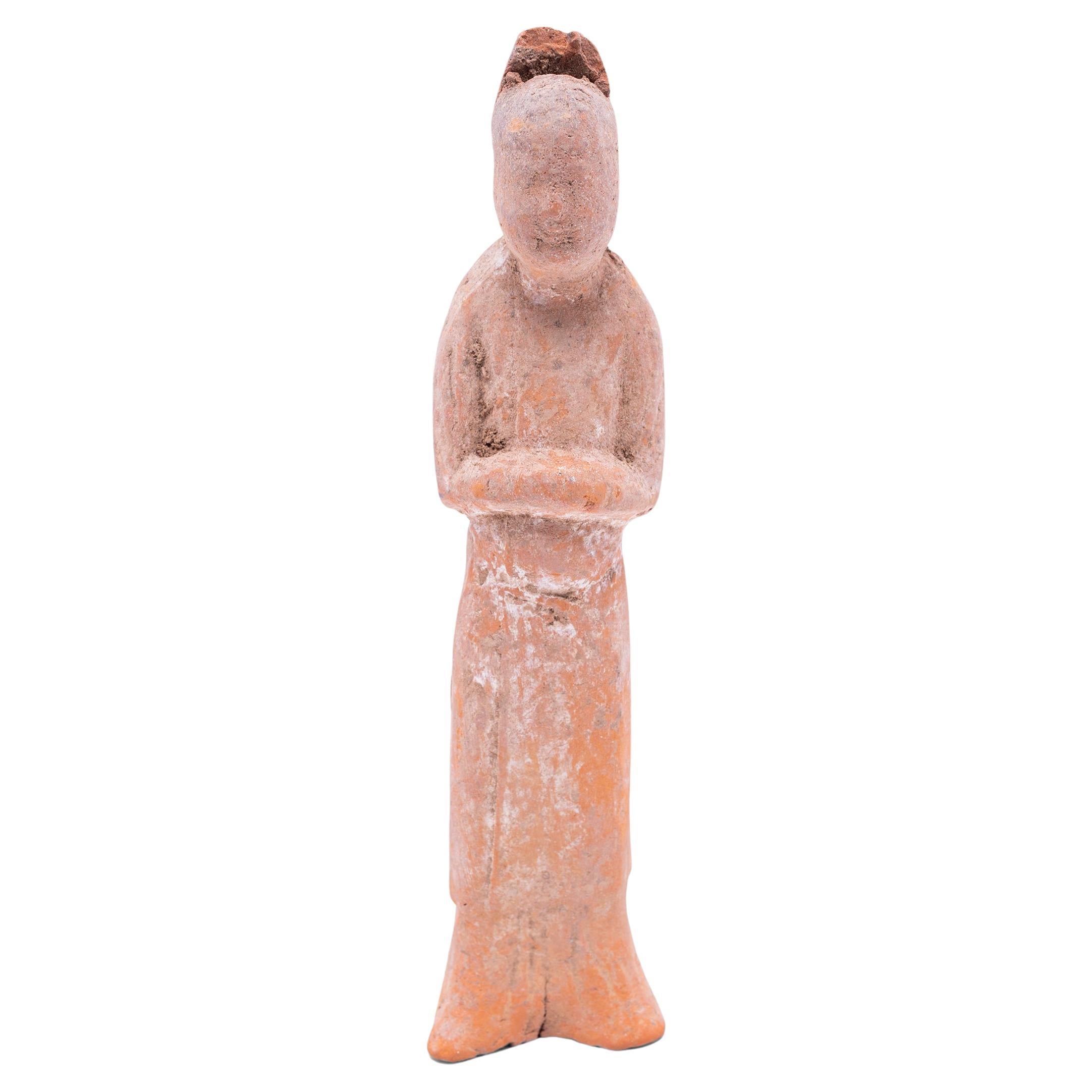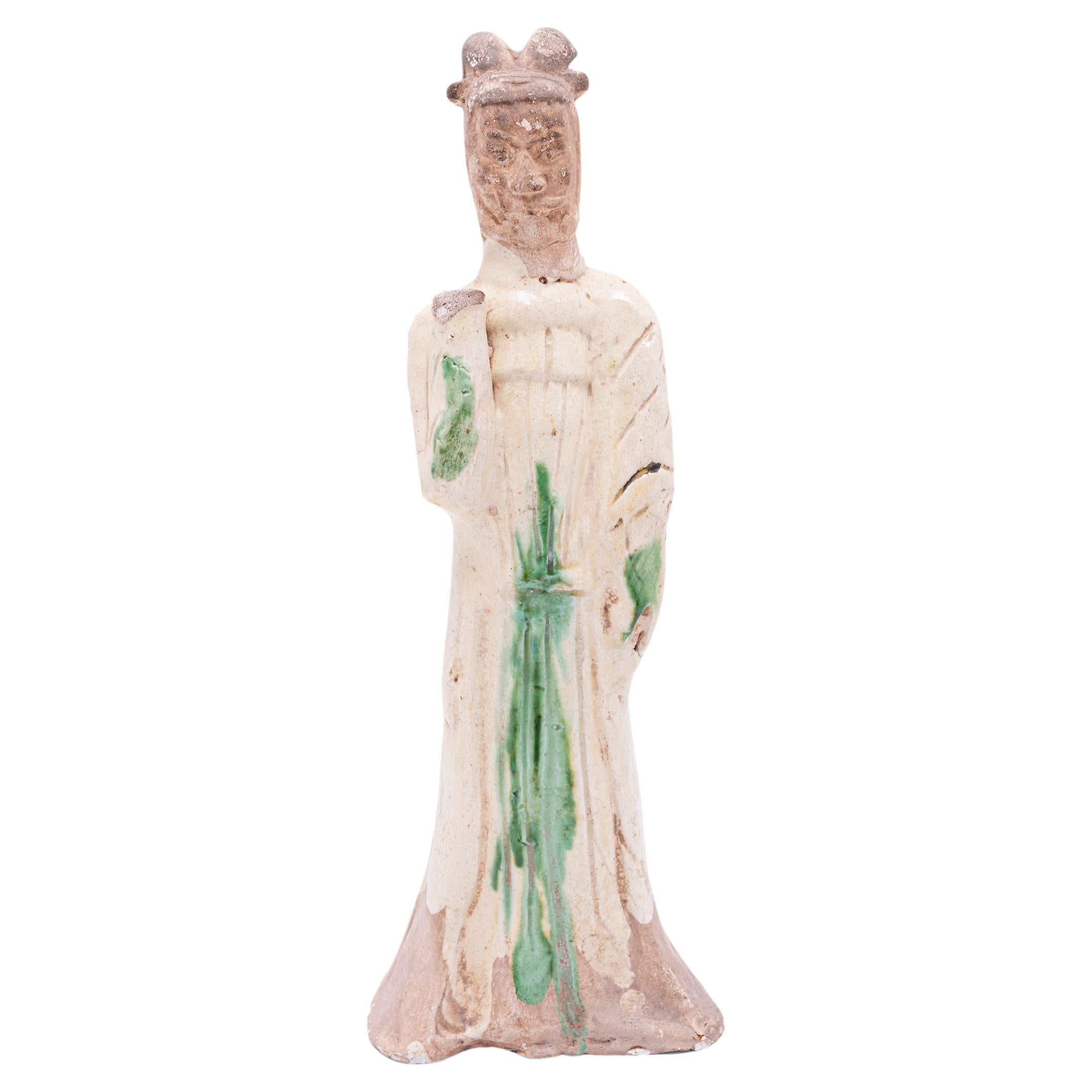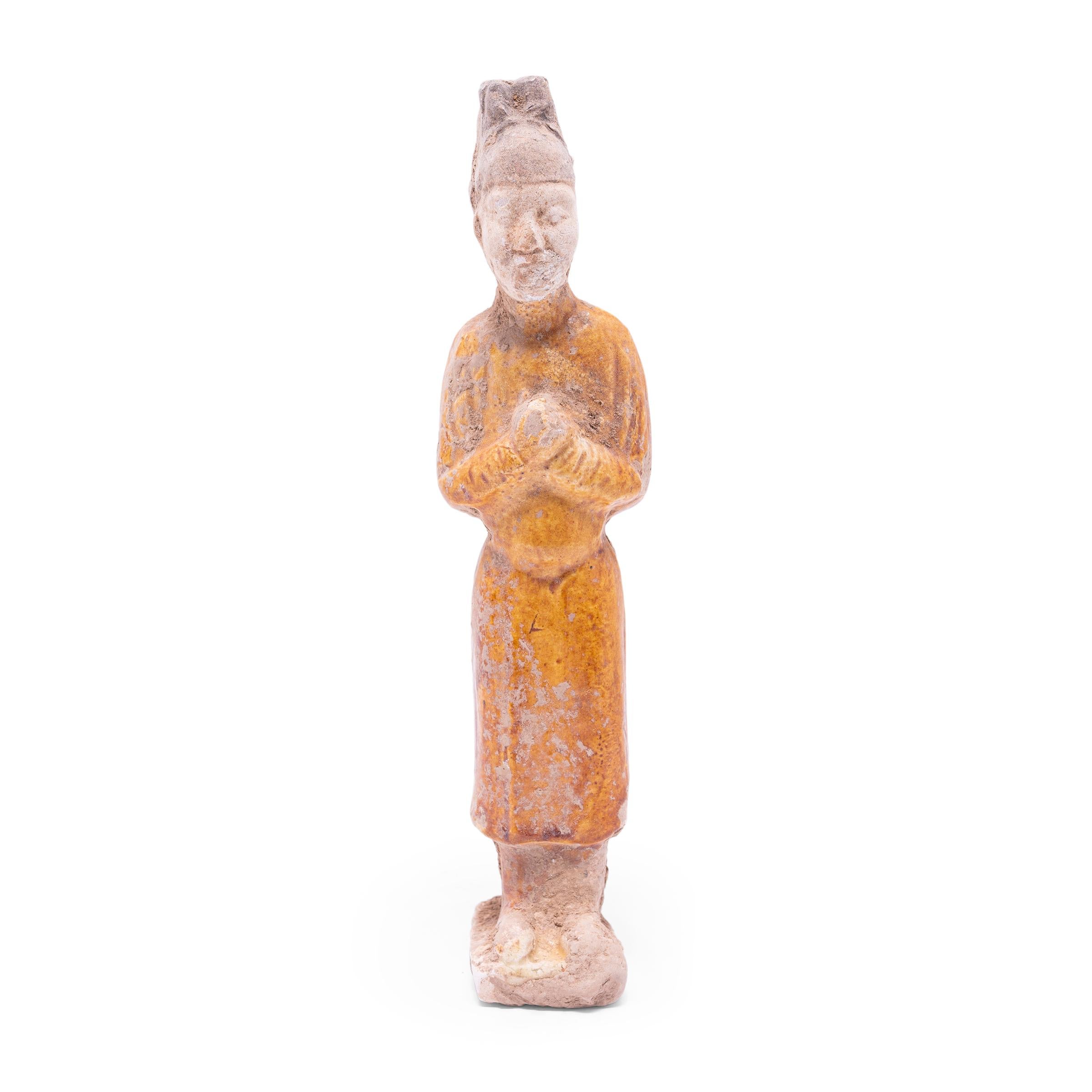Want more images or videos?
Request additional images or videos from the seller
1 of 6
Chinese Male Mingqi Spirit Attendant
About the Item
Molded of earthenware, this petite sculpture is a type of centuries-old burial figurine known as míngqì. Such model figures were placed in tombs of individuals with high status to ensure a safe journey to the afterlife. Meant to depict the pleasures of daily life, common burial figures were warriors, dancers, male and female figures and animals.
This míngqì is of a male attendant dressed in a long gown, hands folded in front and topped by a towering coiffure or headdress. The sculpture is coated with a pale glaze and has now weathered from age, revealing the original ceramic form.
- Dimensions:Height: 10.25 in (26.04 cm)Width: 3 in (7.62 cm)Depth: 2.5 in (6.35 cm)
- Materials and Techniques:
- Place of Origin:
- Period:
- Date of Manufacture:Unknown
- Condition:Wear consistent with age and use. Minor losses. Minor structural damages.
- Seller Location:Chicago, IL
- Reference Number:

About the Seller
4.9
PAGODA RED is a renowned resource for designers as well as collectors of contemporary and ancient Chinese, Korean and Japanese art. They offer a curated edit of fine and provincial furniture, ceramics, scholars' objects, and paintings and textiles, each piece historically and geographically authentic.
Diamond Seller
These expertly vetted sellers are 1stDibs' most experienced sellers and are rated highest by our customers.
Established in 1997
1stDibs seller since 2006
1,416 sales on 1stDibs
Typical response time: 1 hour
- ShippingRetrieving quote...Ships From: Chicago, IL
- Return PolicyA return for this item may be initiated within 2 days of delivery.
More From This SellerView All
- Chinese Male Mingqi Spirit AttendantLocated in Chicago, ILMolded of earthenware, this petite sculpture is a type of centuries-old burial figurine known as míngqì. Such model figures were placed in tombs of individuals with high status to en...Category
Antique 15th Century and Earlier Chinese Antiquities
MaterialsCeramic
- Chinese Male Mingqi Spirit AttendantLocated in Chicago, ILMolded of earthenware, this petite sculpture is a type of centuries-old burial figurine known as míngqì. Such model figures were placed in tombs of individuals with high status to en...Category
Antique 15th Century and Earlier Chinese Chinese Export Antiquities
MaterialsCeramic
- Sancai Mingqi Spirit AttendantLocated in Chicago, ILMolded of earthenware, this petite sculpture is a type of centuries-old burial figurine known as míngqì. Such model figures were placed in tombs of individuals with high status to en...Category
Antique 15th Century and Earlier Chinese Chinese Export Antiquities
MaterialsCeramic
- Green Glazed Chinese Mingqi Spirit ScholarLocated in Chicago, ILMolded of earthenware, this petite sculpture is a type of centuries-old burial figurine known as míngqì. Such model figures were placed in tombs of individuals with high status to en...Category
Antique 15th Century and Earlier Chinese Chinese Export Antiquities
MaterialsCeramic
- Chinese Yellow Glazed Mingqi Spirit ScholarLocated in Chicago, ILMolded of earthenware, this petite sculpture is a type of centuries-old burial figurine known as míngqì. Such model figures were placed in tombs of individuals with high status to en...Category
Antique 15th Century and Earlier Chinese Antiquities
MaterialsCeramic
- Blue Glazed Chinese Mingqi Spirit ScholarLocated in Chicago, ILMolded of earthenware, this petite sculpture is a type of centuries-old burial figurine known as míngqì. Such model figures were placed in tombs of individuals with high status to en...Category
Antique 15th Century and Earlier Chinese Antiquities
MaterialsCeramic
You May Also Like
- Tang Dynasty, Antique Chinese Pottery Male Attendant FigureLocated in Sampantawong, THChinese pottery male attendant figure. Age: China, Tang Dynasty, A.D. 618 - 907 Size: Height 17.6 C.M. / Width 5.5 C.M. Condition: Well-preserved old burial condition overall with s...Category
Antique 15th Century and Earlier Chinese Antiquities
MaterialsPottery
- Superb Set of 5 Elegant Court Attendants, Ming Dynasty, 1368-1644 AD TL TestedLocated in San Pedro Garza Garcia, Nuevo LeonA stunning set of 5 graceful terracotta figurines from the Ming Dynasty '1368-1644' AD. These elegant attendants are standing on a yellow glazed lotus flower over a high hexagonal green plinth and wear fine robes in matching green and yellow glazes. The unglazed areas have pigmented colors in red, black and white. Each is carrying essential offerings for the royal family. The head is detachable as often seen on the larger figures from this period. Meticulously detailed facial expressions have been hand-painted. Condition: Mint, finely preserved glaze and pigment, undamaged and no repairs. Provenance: Ex. Danish Collection. This set is guaranteed authentic and comes with a Certificate of Authenticity and TL Test from Laboratory Kotalla in Germany (The Oldest Thermoluminescence Testing Laboratory in the World). Dimensions: Average 54 H cms Burial figurines of graceful dancers, mystical beasts, and everyday objects reveal both how people in early China approached death and how they lived. Since people viewed the afterlife as an extension of worldly life, these figurines, called mingqi, sometimes referred as “spirit utensils” or “vessels of ghosts” disclose details of routine existence and provide insights into belief systems over a thousand-year period. The Ming dynasty was the ruling dynasty of China – then known as the Empire of the Great Ming – for 276 years (1368–1644 AD). Founded by Chu Yuan-chang, the rebel leader that was successful in removing the mongols from the throne. Chinese control was re-asserted in China and eastern Asia. Literature became more important, schools were created, and the justice system was reformed. The Ming dynasty is described by some as "one of the greatest eras of orderly government and social stability in human history,” was the last imperial dynasty in China ruled by ethnic Han Chinese. The practice of burying ceramic objects with the deceased went into decline from the 10th to the 14th Century AD. There was a revival in placing miniature representations of glazed terracotta objects such a furniture, food offerings, horses, miniature statues...Category
Antique 15th Century and Earlier Chinese Ming Antiquities
MaterialsTerracotta
- Chinese Siwa Culture Burnished Pottery Jar, 1500 - 1100 BC, ChinaLocated in Austin, TXA striking Chinese Neolithic to Bronze Age burnished red pottery double handled saddle mouth storage jar, Siwa Culture (circa 1500 to 1100 BC), modern day Gansu Province, China. ...Category
Antique 15th Century and Earlier Chinese Ceramics
MaterialsPottery
- Chinese Cocoon Jar, Burnished Gray Pottery, Western Han Dynasty, ChinaLocated in Austin, TXA classic Chinese Han Dynasty "cocoon jar" of high fired burnished gray pottery, Western Han Dynasty (206 BC - 9 AD), China. The jar of typical form, w...Category
Antique 15th Century and Earlier Chinese Han Antiquities
MaterialsPottery
- Chinese Gray Potter Tripod Pouring Vessel, He, Warring States Period, ChinaLocated in Austin, TXAn unusual Chinese gray pottery pouring vessel, he, Warring States or early Han Dynasty, circa 4th - 3rd century BC, China. The pouring vessel, calle...Category
Antique 15th Century and Earlier Chinese Han Ceramics
MaterialsPottery
- Chinese Neolithic Qijia Culture Red Pottery Vessel, 2200 BC - 1600 BC, ChinaLocated in Austin, TXAn attractive Neolithic Chinese burnished red pottery vessel, Qijia Culture (2200 BC - 1600 BC), modern day Gansu Province, China. The vessel of compressed globular form set on a short, pieced pedestal foot, and featuring two ear handles, a short, wide neck, and slightly everted mouth. A simple incised band decorates the otherwise plain body. The red pottery with a beautiful rich terracotta hue. The slight burnishing makes the vessel glow. The Qijia Culture was a late Neolithic...Category
Antique 15th Century and Earlier Chinese Ceramics
MaterialsPottery
Recently Viewed
View AllMore Ways To Browse
Tomb Attendant
Buddha Naga Wood
Office Art
White Dining Room Furniture
Metal And Wood
Mirrored Hall Entry
Traditional Wool Traditional Rug
Dining Table Circa
A Paul
Brass Table Lamp Office
Country Of Origin
Simple Elegant
French Serveware Ceramics Silver Glass
Wood And Metal Table
Antique Gilted Furniture
Wood Stones
Studio Craft Dining
Cabinet Space





